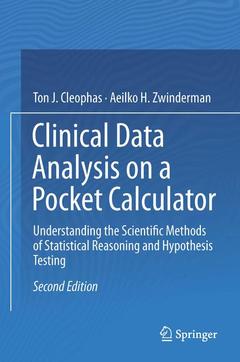Description
Clinical Data Analysis on a Pocket Calculator (2nd Ed., Softcover reprint of the original 2nd ed. 2016)
Understanding the Scientific Methods of Statistical Reasoning and Hypothesis Testing
Authors: Cleophas Ton J., Zwinderman Aeilko H.
Language: English
Subjects for Clinical Data Analysis on a Pocket Calculator:
Approximative price 89.66 €
In Print (Delivery period: 15 days).
Add to cartPublication date: 01-2016
Support: Print on demand
89.66 €
In Print (Delivery period: 15 days).
Add to cartPublication date: 03-2018
Support: Print on demand
Description
/li>Contents
/li>Biography
/li>Comment
/li>
In medical and health care the scientific method is little used, and statistical software programs are experienced as black box programs producing lots of p-values, but little answers to scientific questions. The pocket calculator analyses appears to be, particularly, appreciated, because they enable medical and health professionals and students for the first time to understand the scientific methods of statistical reasoning and hypothesis testing. So much so, that it can start something like a new dimension in their professional world. In addition, a number of statistical methods like power calculations and required sample size calculations can be performed more easily on a pocket calculator, than using a software program. Also, there are some specific advantages of the pocket calculator method. You better understand what you are doing. The pocket calculator works faster, because far less steps have to be taken, averages can be used. The current nonmathematical book is complementary to the nonmathematical "SPSS for Starters and 2nd Levelers" (Springer Heidelberg Germany 2015, from the same authors), and can very well be used as its daily companion.
Preface.-I Continuous Outcome Data.- Data Spread, Standard Deviations.- Data Summaries: Histograms, Wide and Narrow Gaussian Curves.- Null-Hypothesis Testing with Graphs.- Null-Hypothesis Testing with the T-table.- One-Sample Continuous Data (One-Sample T-Test, One-Sample Wilcoxon.- Paired Continuous Data (Paired T-Test, Two-Sample Wilcoxon Signed Rank Test).- Unpaired Continuous Data (Unpaired T-Test, Mann-Whitney).- Linear Regression (Regression Coefficients, Correlation Coefficients, and their Standard Errors).- Kendall-Tau Regression for Ordinal Data.- Paired Continuous Data, Analysis with Help of Correlation Coefficients.- Power Equations.- Sample Size Calculations.- Confidence Intervals.- Equivalence Testing instead of Null-Hypothesis Testing.- Noninferiority Testing instead of Null-Hypothesis Testing.- Superiority Testing instead of Null-Hypothesis Testing.- Missing Data Imputation.- Bonferroni Adjustments.- Unpaired Analysis of Variance (ANOVA).- Paired Analysis of Variance (ANOVA).-Variability Analysis for One or Two Samples.- 22 Variability Analysis for Three or More Samples.- Confounding.- Propensity Score and Propensity Score Matching for Multiple Confounders.- Interaction.- Accuracy and Reliability Assessments.- Robust Tests for Imperfect Data.- Non-linear Modeling on a Pocket Calculator.- Fuzzy Modeling for Imprecise and Incomplete Data.- Bhattacharya Modeling for Unmasking Hidden Gaussian Curves.- Item Response Modeling instead of Classical Linear Analysis of Questionnaires.- Meta-Analysis.- Goodness of Fit Tests for Identifying Nonnormal Data.- Non-Parametric Tests for Three or More Samples (Friedman and Kruskal-Wallis).- II Binary Outcome Data.-Data Spread: Standard Deviation, One Sample Z- Test, One Sample Binomial Test.- Z-Tests.- Phi Tests for Nominal Data.- 38 Chi-Square Tests.- Fisher Exact Tests Convenient for Small Samples.- Confounding.- Interaction.- Chi-square Tests for Large Cross-Tabs.- Logarithmic Transformations, a Great Help to Statistical Analyses .- Odds Ratios, a Short-Cut for Analyzing Cross-Tabs.- Log odds, the Basis of Logistic Regression.- Log Likelihood Ratio Tests for the Best Precision.- Hierarchical Loglinear Models for Higher Order Cross-Tabs.- McNemar Tests for Paired Cross-Tabs.- McNemar Odds Ratios.- Power Equations.- Sample Size Calculations.- Accuracy Assessments.- Reliability Assessments.- Unmasking Fudged Data.- Markov Modeling for Predictions outside the Range of Observations.- Binary Partitioning with CART (Classification and Regression Tree) Methods.- Meta-Analysis.- Physicians' Daily Life and the Scientific Method.- Incident Analysis and the Scientific Method.- Cochran Tests for Large Paired Cross-Tabs.-Index.
The authors are well-qualified in their field. Professor Zwinderman is past-president of the International Society of Biostatistics (2012-2015), and Professor Cleophas is past-president of the American College of Angiology (2000-2002). From their expertise they should be able to make adequate selections of modern methods for clinical data analysis for the benefit of physicians, students, and investigators. The authors have been working and publishing together for 17 years, and their research can be characterized as a continued effort to demonstrate that clinical data analysis is not mathematics but rather a discipline at the interface of biology and mathematics.
The authors as professors and teachers in statistics at universities in The Netherlands and France for the most part of their lives, are convinced that the scientific method of statistical reasoning and hypothesis testing is little used by physicians and other health workers, and they hope that the current productionwill help them find the appropriate ways for answering their scientific questions.
Three textbooks complementary to the current production and written by the same authors are Statistics applied to clinical studies 5th edition, 2012, Machine learning in medicine a complete overview, 2015, SPSS for starters and 2nd levelers, 2015, all of them edited by Springer Heidelberg Germany.
These books may interest you

SPSS for Starters, Part 2 52.70 €



